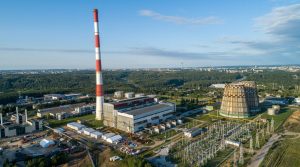In today’s competitive industrial landscape, managing operational costs is crucial for maintaining profitability. Energy, especially with cogeneration systems, is often one of the largest expenses for manufacturing plants, making efficiency a top priority.
One proven strategy for reducing energy consumption by up to 30% is through the implementation of cogeneration systems, also known as Combined Heat and Power (CHP).
In this article, we’ll explore how CHP systems work and why they’re a smart investment for factories looking to slash energy costs while boosting sustainability.
- What is Cogeneration?
- The 30% Energy Savings Explained
- Key Benefits of Cogeneration in a Factory Setting
- How to Implement Cogeneration in Your Factory
- Overcoming Common Challenges in Cogeneration Implementation
- The Future of Energy Efficiency with Cogeneration
- Explore Cogeneration Solutions with İltekno
What is Cogeneration?
Cogeneration, or CHP, is an energy system that simultaneously produces electricity and useful heat from a single energy source, such as natural gas, biogas, or biomass.
Unlike traditional systems that generate electricity and waste significant amounts of heat, cogeneration captures that heat and puts it to productive use—like heating water, controlling temperatures in manufacturing processes, or even cooling through absorption chillers.
By combining these processes, CHP systems can achieve overall efficiency rates of up to 90%, far beyond the typical 30-55% efficiency of separate electricity and heating systems.
The 30% Energy Savings Explained
So, how exactly can a cogeneration system reduce your factory’s energy consumption by up to 30%? The secret lies in its efficiency.
By recovering and utilizing waste heat that traditional systems would simply discard, cogeneration drastically reduces the amount of fuel needed to achieve the same energy output. This translates to lower overall fuel consumption, reduced reliance on grid electricity, and significant savings on your energy bills.
Additionally, on-site power generation cuts out the transmission losses that occur when electricity is delivered over long distances, further enhancing savings.
Key Benefits of Cogeneration in a Factory Setting
- Cost Savings: By optimizing fuel use and reducing waste, cogeneration systems can deliver substantial cost reductions. Many businesses see a return on investment (ROI) within 2-3 years, with ongoing savings for the lifespan of the system, typically 10-15 years.
- Improved Energy Reliability: On-site energy generation reduces dependency on the grid and mitigates the risks of power outages, ensuring uninterrupted production.
- Environmental Benefits: CHP systems produce fewer greenhouse gas emissions compared to traditional energy systems, especially when powered by renewable fuels like biogas.
- Fuel Flexibility: Factories can choose the most cost-effective and sustainable fuel source available, including natural gas, biogas, and even hydrogen as the technology advances.
How to Implement Cogeneration in Your Factory
Considering cogeneration for your facility? The first step is assessing your energy needs. Cogeneration is most effective in factories with high and continuous demands for both heat and electricity, such as in food processing, paper production, or heavy manufacturing. Here’s how to proceed:
- Evaluate Feasibility: Conduct a site analysis to determine the potential benefits and ROI.
- Choose the Right System Size: Properly sizing the CHP system is crucial to maximizing efficiency and savings.
- Engage with Energy Experts: Partner with an energy service company that specializes in CHP systems for guidance, from initial assessment to installation and ongoing maintenance.
Overcoming Common Challenges in Cogeneration Implementation
While the benefits are clear, implementing cogeneration systems can come with challenges. Upfront costs, regulatory requirements, and maintenance needs are some of the common hurdles.
However, these obstacles can be mitigated through flexible financing options like power purchase agreements (PPAs) and energy service contracts. These options allow businesses to adopt CHP without heavy capital investment, enabling them to start saving on energy immediately.
The Future of Energy Efficiency with Cogeneration
As technology continues to advance, the future of cogeneration looks even more promising. Emerging innovations like fuel cells, hydrogen integration, and the combination of CHP with renewable energy sources are set to further increase efficiency and reduce environmental impact. For factories aiming for net-zero emissions, investing in cogeneration is a step in the right direction, offering both short-term savings and long-term sustainability.
Cogeneration systems offer a compelling solution for factories looking to achieve significant energy savings while enhancing operational reliability and reducing environmental impact. With potential savings of up to 30%, CHP systems represent a smart investment that pays dividends for years to come.
Explore Cogeneration Solutions with İltekno
Are you ready to explore how cogeneration can help your facility save on energy costs and achieve your sustainability goals?
At İltekno, we specialize in providing comprehensive cogeneration solutions tailored to meet your specific needs. Established in 1989, İltekno has over three decades of experience in designing, installing, and maintaining power plants, including cogeneration, trigeneration, and other energy systems. With more than 320 successful projects across 24 countries, we are recognized as a trusted leader in the industry.
Whether you’re considering a new installation or upgrading your existing systems, our expert team offers in-house engineering, design, procurement, and after-sales services to ensure customer satisfaction.
We’ve helped numerous facilities reduce their energy costs, enhance reliability, and minimize environmental impact. As a distributor and solution partner of MWM and Siemens, we have the expertise and resources to deliver the best solutions for your business.
If you’re interested in taking the next step, contact us today for a detailed assessment and discover how İltekno can help you achieve your energy efficiency and sustainability goals with a cogeneration system. Let’s work together to create a more efficient and sustainable future for your facility.



